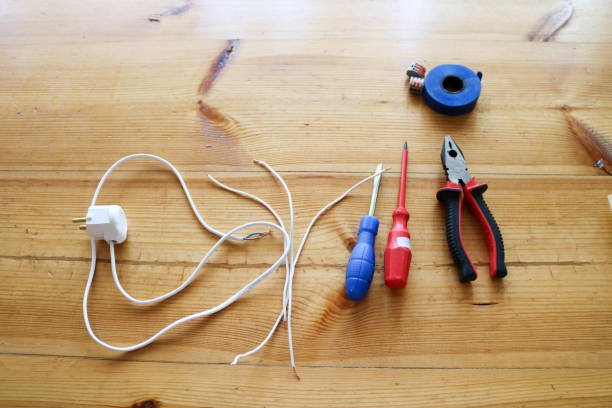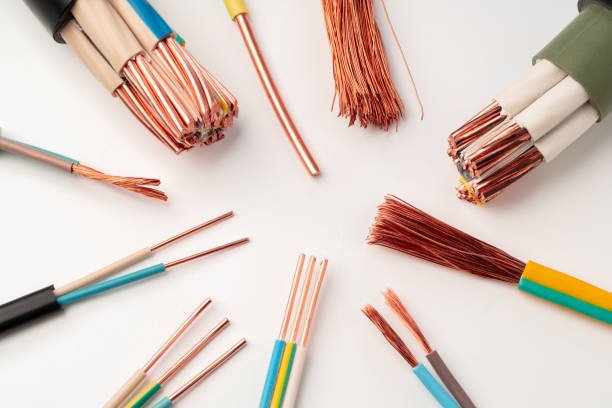Rewiring a plug is an essential skill for every UK homeowner. Whether you’re replacing a damaged plug, wiring a new appliance, or fixing a frayed cable, this comprehensive guide will walk you through the process safely and efficiently, following all British safety standards and regulations.
Knowing how to properly rewire a standard UK three-pin plug can save you time and money while ensuring your electrical appliances remain safe to use. You might need to rewire a plug when:
- The original plug is damaged or cracked
- You’ve purchased a new appliance with an unwired plug
- The cable near the plug has become frayed or worn
- You need to replace the fuse after it has blown
In the UK, all plugs must conform to British Standard BS 1363, which specifies the design of 13-amp plugs, sockets, and adaptors. This standard, unique to the UK and some Commonwealth countries, ensures electrical safety with features like individual fuses and insulated pin bases.
Most adults can safely rewire a plug by following proper instructions. However, if you have mobility issues, visual impairments, or any doubt about your ability to complete the task safely, it’s best to ask for assistance or consult a qualified electrician.
Table of Contents
Tools and Materials You’ll Need

Before starting, gather these essential items:
- Replacement plug (must conform to BS 1363 standard)
- Small flat-head screwdriver
- Small Phillips screwdriver (cross-head)
- Wire cutters/strippers
- Correct fuse (3A, 5A, or 13A depending on your appliance)
- Optional: Voltage tester for safety checks
Pro tip: Always choose replacement plugs bearing the British Standard Kitemark or the ASTA mark, confirming they meet UK safety standards.
Understanding UK Plug Wiring Colour Codes

The UK follows specific wiring colour codes that are crucial to understand before rewiring a plug:
- Brown wire = Live (L) – Carries electricity to your appliance
- Blue wire = Neutral (N) – Completes the electrical circuit
- Green and Yellow striped wire = Earth (E) – Provides a safety path for fault currents
Important note: If you’re working with an older appliance (pre-2006), you might encounter the old colour coding system:
- Red = Live (now Brown)
- Black = Neutral (now Blue)
- Green = Earth (now Green/Yellow)
Step-by-Step Guide to Rewiring a Plug
Step 1 – Remove the Plug Cover
- Ensure the appliance is unplugged from the wall socket
- Locate the large central screw on the underside of the plug
- Unscrew it using your screwdriver, turning anti-clockwise
- Carefully lift off the plug cover to reveal the internal components
Safety tip: Never attempt to open a plug while it’s connected to a power source.
Step 2 – Inspect and Strip the Cable
- If replacing an old plug, remove the old wiring by loosening each terminal screw
- Examine your cable to ensure it’s in good condition with no cuts or fraying
- Strip approximately 3cm (about 1 inch) of the outer cable sheath
- Strip about 1cm (3/8 inch) of insulation from the end of each coloured wire
- Twist the exposed copper strands of each wire to prevent stray strands
Pro tip: Be careful not to remove too much insulation from the wires, as exposed copper outside the terminals creates a shock hazard.
Step 3 – Connect the Wires to the Correct Terminals
In a UK plug, the terminals are arranged in this layout:
- Top pin: Earth (E) – Connect the green/yellow wire
- Bottom left pin: Neutral (N) – Connect the blue wire
- Bottom right pin: Live (L) – Connect the brown wire
To make the connections:
- Loosen the terminal screws
- Insert the stripped end of each wire into its correct terminal:
- Green/yellow wire into the terminal marked E or ⏚ (usually at the top)
- Blue wire into the terminal marked N (usually bottom left)
- Brown wire into the terminal marked L (usually bottom right)
- Make sure no copper strands are visible outside the terminal
- Tighten each terminal screw firmly to secure the wires
Remember this rhyme: “Brown is live and should be right, Blue is neutral and out of sight, Green and yellow earth wires go to the top so they will never stop.”
Step 4 – Secure the Cable Clamp
- Position the cable so the outer sheath extends into the plug by about 1cm past the cord grip
- Ensure the cord grip clamps onto the outer sheath, not the individual coloured wires
- Tighten the cord grip screws evenly until the cable is held firmly
Why it matters: The cord grip prevents strain on the terminal connections if someone pulls on the cable, reducing the risk of wires coming loose.
Step 5 – Insert the Correct Fuse
UK plugs contain a fuse as an additional safety feature. Selecting the right fuse is crucial:
- 3A fuse (red): For appliances rated up to 700W (lamps, radios, TVs, computers)
- 5A fuse (black): For appliances between 700W and 1200W (less common)
- 13A fuse (brown): For appliances rated between 1200W and 3000W (kettles, heaters)
To insert the fuse:
- Check your appliance manual for the recommended fuse rating
- If you’re unsure, use this rule of thumb: appliance wattage ÷ 240V = amperage needed
- Insert the appropriate fuse into the fuse holder
- Ensure it sits securely in place
Safety tip: Never use a higher-rated fuse than necessary, as this undermines the safety protection.
Step 6 – Reassemble and Test the Plug
- Double-check all connections are tight and correct
- Carefully fold any excess wire inside the plug
- Replace the plug cover and tighten the central screw
- Visually inspect the completed plug
- Plug the appliance into a socket and test its functionality
Final check: The plug should feel solid with no loose parts, and the cable should exit smoothly without sharp bends.
Common Mistakes to Avoid
When rewiring a UK plug, watch out for these frequent errors:
- Swapping the live and neutral wires: This can be dangerous and may damage your appliance
- Leaving exposed copper wire: All copper must be inside the terminals with only insulation visible
- Using an incorrect fuse rating: Too high a rating compromises safety; too low will cause nuisance blowing
- Loose terminal screws: These can cause overheating and potentially fires
- Not securing the cord grip properly: This puts strain on connections and increases wear on the cable
- Cutting away too much outer sheath: Individual wires should not be visible outside the plug
Safety Tips When Rewiring a Plug
- Always disconnect the appliance from the power supply before beginning work
- Work in a well-lit area on a non-conductive surface
- Keep children and pets away while working with electrical components
- Never use excessive force when tightening screws; this can damage the plug
- If you notice burn marks, melting, or unusual smells, discard the plug and use a new one
When Should You Replace Instead of Rewire?
Some situations call for replacing the plug entirely rather than rewiring:
- When the plug casing is cracked or damaged
- If the pins are bent, loose, or showing signs of corrosion
- When the terminal posts inside are burnt or damaged
- If the fuse holder is broken or doesn’t hold the fuse securely
- When the cord grip mechanism is broken or can’t be tightened properly
- If the cable entering the plug is frayed or damaged
Professional advice: If you notice any signs of overheating or burning inside an appliance plug, have the entire appliance checked by a qualified electrician as this could indicate a serious fault.
Understanding the UK Plug Design
The British three-pin plug is considered one of the safest in the world, with several unique safety features:
- Individual fusing: Each appliance has its own appropriate fuse
- Insulated pins: The live and neutral pins have insulated sleeves to prevent accidental contact
- Shuttered sockets: The earth pin opens safety shutters that allow access to the live and neutral slots
- Polarized design: The plug can only be inserted one way into the socket
These features have made the UK plug design so effective that it has been adopted by several other countries, including Ireland, Malaysia, Singapore, and Hong Kong.
Special Cases in UK Plug Wiring
Double-Insulated Appliances
Some appliances are marked with a double-square symbol (⧈) indicating they are double-insulated. These appliances have only two wires (brown and blue) and don’t require an earth connection for safe operation. When wiring such plugs:
- Connect the brown wire to the live (L) terminal
- Connect the blue wire to the neutral (N) terminal
- Leave the earth (E) terminal empty
High-Current Appliances
For appliances that draw close to 13 amps (like electric heaters or kettles), make sure:
- The cable is of adequate thickness (at least 1.25mm²)
- All connections are especially tight
- You use the correct 13A fuse
FAQs About Plug Rewiring (UK)
Can I rewire any UK plug myself?
Yes, you can legally rewire standard 13A plugs yourself in the UK. However, for specialised industrial plugs or in commercial settings, you might need to be a qualified electrician.
How do I choose the right fuse for my appliance?
Check the appliance’s manual or rating plate for the recommended fuse. As a general guide:
- 3A fuse for appliances up to 700W (most lamps, radios, TVs, computers)
- 13A fuse for appliances between 700W and 3000W (kettles, heaters, irons)
What’s the risk of wiring a plug incorrectly?
Incorrect wiring can cause electric shocks, damage to appliances, and electrical fires. Swapping the live and neutral wires is particularly dangerous as it may make metal parts of an appliance live even when switched off.
Are there legal regulations for plug wiring in the UK?
Yes, the Plugs and Sockets etc. (Safety) Regulations 1994 mandate that all plugs sold must conform to BS 1363 standards. While DIY rewiring is permitted, all fixed electrical installations must comply with Part P of the Building Regulations.
Do all appliances need an earth wire?
Not all appliances require an earth connection. Double-insulated appliances (marked with a square within a square symbol ⧈) don’t need an earth wire for safe operation.
How often should I check my plugs?
It’s good practice to visually inspect the plugs of frequently used appliances every few months. Look for signs of damage, overheating, or loose parts.
The History of the UK Plug
The current British three-pin plug design was introduced as part of the post-World War II rebuilding effort. The BS 1363 standard was established in 1947 as a safer alternative to the variety of plug types previously in use. Its robust design was intended to withstand the challenges of the era, including materials shortages and the need for safer electrical systems in new housing.
Today, the UK plug is often cited as one of the safest electrical connection systems globally, despite sometimes being criticized for its bulky size and potential to cause pain when stepped on barefoot!
Conclusion
Rewiring a plug is a straightforward yet essential skill for any UK resident. By following this guide, you can ensure your electrical appliances remain safe and functional. Remember that electrical safety should never be compromised – take your time, double-check your work, and don’t hesitate to seek professional help if you’re uncertain about any aspect of the process.
Properly wired plugs prevent electrical accidents and extend the life of your appliances. With practice, you’ll be able to rewire a plug confidently in just a few minutes, saving yourself time and money while ensuring your home remains electrically safe.



